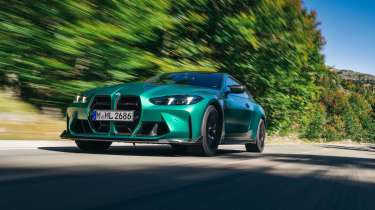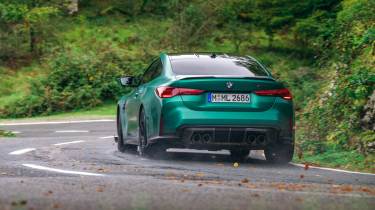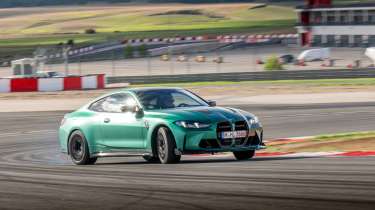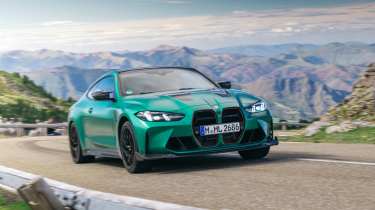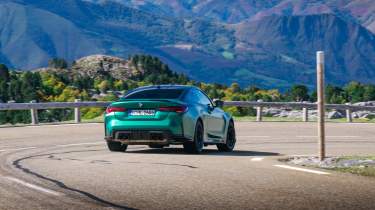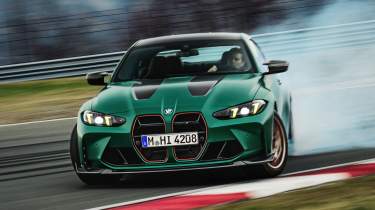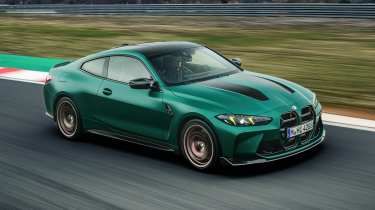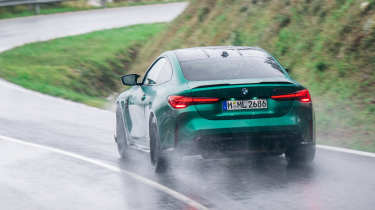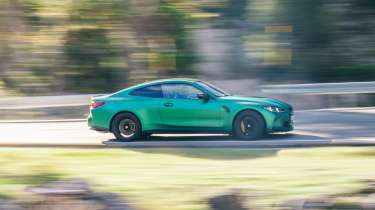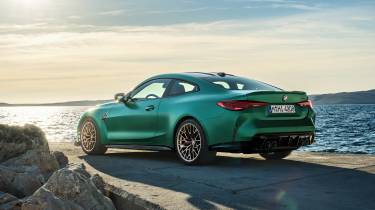BMW M4 CS 2025 review – the M4 sweet spot we’ve been waiting for?
First on the launch at the Salzburgring, then on evo Car of the Year 2024, we find out if the M4 CS is a high watermark for BMW's Motorsport division.
BMW M’s CS package has proven to be the sweet-spot specification to get the very best from the latest crop of M cars. Back-to-back evo Car of the Year victories in 2020 and 2021 for the BMW M2 CS and M5 CS respectively, a strong showing from the M3 CS in ‘23’s eCoty and 2024’s Track Car of the Year set high expectations for the next instalment: the M4 CS. It gets the same attention to detail and forensic tuning of key components as its forebears and we examined it on road and track at both the international launch and on the evo Car of the Year 2024 test.
BMW has already delivered quite a few of the many permutations available to it with M3 saloon and Touring, M4 coupe and Convertible, plus Competition, CS and CSL specs, and rear-drive and M xDrive four-wheel drive. The M4 CS seemingly brings nothing new to the party but may be the most desirable derivative of all.
When the M4 first appeared in 2021 in rear-drive Competition trim (evo 284), we wondered whether its hefty 1725kg kerb weight was compatible with its dynamic ambitions. Yet after half an hour on decent roads it was apparent that the willingness and capability of its chassis and the abundance of its performance rendered that kerb weight almost irrelevant. And on the West Circuit at Bedford, with DSC disabled and ‘Drift Analyser’ engaged, it proved spectacularly playful and poised, its 503bhp, twin-turbo straight-six offering seemingly endless urge.
How do you improve on that? The limited-edition, 1000-off, rear-wheel-drive CSL should have raised the bar, being 100kg lighter, partly by dint of deleting the rear seats. It also swapped lots of compressible suspension bushes for uniball joints, retuned the suspension with uprated springs, and boosted the straight-six to a more aggressive 542bhp. It looked like being the ultimate in terms of dynamic clarity, yet while we found it compelling, the CSL was somewhat unresolved, a car that was less than the sum of its parts.
More reviews
Perhaps counter-intuitively, adding another 50kg to the M4 Comp improved the experience. That was the weight of the xDrive four-wheel-drive hardware. Much as we love the combo of smoking rear tyres and a generous armful of opposite lock, it was undeniable that xDrive added to the capability of the M4, especially in less than ideal conditions, yet most of the time it felt just as agile and rear-driven as the original.
The new M4 CS has the potential to be the absolute sweet- spot, marrying xDrive with the CSL’s performance and a slug of its aggression. A chunk of its lightweighting, too, including its road wheels (saving 1kg per corner) and numerous carbonfibre parts, among them the bonnet and splitter, plus the dashboard facia and centre console. In all, it takes 15kg off the weight of the Competition. Honestly, that saving on a 1775kg car is neither here nor there, the same as driving with a half tank rather than a full tank of fuel, but the look is very CSL, apart from the boot, which has a carbon gurney rather than the CSL’s unique, moulded, ducktail bootlid.
As well as many of the CSL’s carbon bits, the CS gets its rather curious red detailing which, especially in this new colour, ‘Frozen Isle of Man Green’, makes it look like a car printed slightly out of register, or one that should be viewed through 3D glasses for absolute resolution. Another new colour for the coupe is Riviera Blue (unfortunately remarkably close to British Gas van blue), while the wheels are either gold or matt black.
In terms of mechanical changes compared to the Competition, the M4 CS’s spring rates are stiffer by three per cent at the front and five per cent at the rear (the CSL was 4.5 and 10 per cent stiffer), with the dampers retuned to suit, while the anti-roll-bar drop-links are uniball-jointed, giving crisper roll response. Completing the upgrades, a cast aluminium brace spans the engine bay and there’s a titanium back-box and quad tailpipes.
The specification of the M3 CS is identical, right down to the spring rates, so I chose it from the selection of M cars offered for the drive from BMW’s press car base in Garching, near Munich, to the circuit just over the Austrian border a couple of hours away. I love a performance saloon but have to say that the CS detailing with patches of exposed carbonfibre sits better on the two-door coupe than on the visually busier M3 CS saloon.
Hit the starter and the straight-six growls into life with an edge, a slight rasp to the tailpipe noise, but hooked up to the eight-speed DCT gearbox it’s as docile as you like heading into the first of a number of traffic jams. Apart from the view in the mirror and the script under the lacquer on the facia, there is no difference in the view from the driving seat, which is
the familiar carbon-shelled, leather-trimmed bucket with the odd ‘carbon codpiece’ between your thighs. The fat- rimmed and quite large steering wheel teems with detail, has decent feel and is calm on centre but bright and quick when you steer away. It also gains useful weight when you select Sport.
Ramp up the engine mode and the previously subtle, quietly menacing note suddenly fills the cabin with loping, angry bass, like turning on a sub-woofer. It also adds a rolling, popping rumble on the overrun. The occasional opportunity to absolutely pin the throttle and keep it there for a good few seconds is a reminder of what a weapon the CS is, piling on the speed to get to an indicated 250kph (155mph) in very short order, the car nonchalant, comfortable with the pace.
The Salzburgring is nothing like its German neighbour, the Nürburgring. As you approach, the surroundings are awesomely mountainous, with jagged, snow-capped peaks all around, yet when you finally find the circuit, it doesn’t drape itself over the terrain like the Nordschleife but occupies a narrow, green valley between the crags. In fact, a small river runs beneath the pit complex in the centre.
‘If you drop back, I will slow down; if you are close, I will speed up,’ says Sven Esch, a driving dynamics engineer at BMW M. I doubt he’ll have to speed up. I have driven around the Salzburgring once before but it was literally half a lifetime ago and, looking at the circuit map, I’m sure there’s at least one new chicane. So I can’t see myself pushing him along after one warm-up and a few flying laps.
Sven leads in an M3 CS, the saloon with the same 542bhp straight-six as the latest M4 coupe. As we exit the pitlane, I find myself wondering why he isn’t also in an M4 CS, although that thought recedes at the sight of him weaving to warm up his Michelin Cup 2 Rs. I feel obliged to do the same.
The idea is that we’ll be led round at speed so we can learn about the car rather than trying to remember which way the track goes. As warm-up laps go it’s pretty hot, but it shows that the track is quite simple, and that the M4 CS is poised and confidence-inspiring. But I have questions. The main one is why aren’t we getting the chance to drive the M4 CS on the road? Perhaps it’s the potential to find ourselves on the autobahn in a shower on Cup 2 Rs.
Laps in the M4 CS will be limited and drifting is strictly verboten so as not to upset the locals, although no houses are visible. Maybe it’s actually so that we don’t get too carried away. When the M4 Comp was launched, the discovery of the Drift Analyser led some to think it might lead to on-road drifting. In fact, the commitment and space required to score even two stars were well beyond the scope of most road driving. Among evo staff and contributors, the stats of our only five-star drift were crazy: it lasted for 9.5sec and covered 347 yards. It also included two transitions and an upshift to fourth...
The two hairpins at either end of the Salzburgring would be fine launch-pads for five-star ambitions but I reckon the grippy Cup 2 Rs would make it much more difficult to initiate and maintain a slide than regular rubber. These Michelins have a slick-tyre compound with light tread, and after the brisk warm-up lap the levels of lateral grip and traction have increased notably. Also, although the peak power of the CS is up to 542bhp, mainly through raising boost pressure, torque is unchanged from the Competition at 479lb ft (all the way from 2750 to 5950rpm), perhaps to protect the transmission.
As we pass the pits for the second time, Sven is on the radio, asking us to press the M1 mode switch on the steering wheel. This ramps up all the settings to Sport and the gearbox to S3 for the shortest shifts but leaves DSC on. Then he nails it. Game on. I’m still feeling out the grip level at the first chicane and bump over the smooth kerbs, but it’s easier to feel the level of front-end bite hustling into and through the long, usefully banked hairpin that follows.
The nose slices confidently in, you can get on the throttle really early and then keep it pinned, traction total, seemingly without DSC being awakened. It’s easy to clip the apex just so, all the while gathering speed hand-over-fist until you’ve unwound the steering and run right to the edge on the exit and onto the back straight. Phew.
I say straight but it’s about as straight as the lowest section of the Nürburgring, from Bergwerk to Mutkurve. Like that section, it climbs gently and meanders until it crests into an unsighted left. Confirming the CS’s pace, at this point on the third lap we’re clocking 260kph (162mph), though the last place you’re looking is the instruments because after the apex you’re immediately hard on the brakes to lose speed for the suddenly looming, looping right that delivers you to the second hairpin. The optional carbon- ceramic brakes bite hard and the CS sweeps confidently into the right-hander, pressing you hard into the seat bolsters, where you stay for a while.
Going from standing in the pitlane to cornering at c160mph in just three laps is very impressive. I don’t recall doing that at the last launch I was here for, even though that was for the Jaguar XJ220. I have only a hazy recollection of the big Jag, recalling weighty steering, intimidating width and a V6 that was uncouth and clattery at idle but mighty on boost. Oh, and a newspaper journalist wrong-slotting a gear and blowing one up.
That was 1992 – over 30 years ago – and what’s remarkable is that the power and torque figures of the XJ220, a car that briefly (and controversially) held the production car top speed record, are remarkably close to those of the M4 CS. The Jaguar’s 3.5-litre, twin-turbo V6 produced 542bhp and 475lb ft; the BMW’s 3-litre, twin-turbo straight- six makes 542bhp and 479lb ft. The all-aluminium Jaguar weighed only 1470kg, giving it a superior power- to-weight ratio, and it was one of the first cars to lap the Nordschleife in under eight minutes, clocking 7min 46sec. However, further illustrating the relentless pace of development, BMW’s official Ring lap time for the M4 CS is 7min 22sec (the CSL managed 7min 18sec).
The Cup 2 Rs make a huge difference to the performance of the CS, but the M-tuned xDrive system undoubtedly plays its part too. For the final two laps we press M2, ramping things up again, engine and chassis raised to Sport Plus while stability is handled by MDM (M Dynamic Mode). Although this maintains more drive to the rear, around the faster turns neither the front nor the rear feel about to push wide.
Press on even harder, ask more of the chassis and the M4 CS still feels positive, neutral and very grippy. Take even more speed into the looping right, brake even later for the hairpin and you can just feel the rear starting to edge out, but even then the car’s behaviour is poised, calm. At the end of the fifth lap the nose is pushing wide a fraction through the last chicane, but it’s been an impressive display.
You could have more of a challenge if you wanted, switching to pure rear-drive mode, but that doesn’t necessarily mean more fun. In the M3 CS at Cadwell Park for our Track Car of the Year feature, MDM was the perfect setting. It was only apparent that it was four-wheel drive when powering out of the tighter turns, and not because of an intervention but because had it been in rear-drive mode you’d have been busy catching and balancing oversteer.
We can safely say that with optional carbon-ceramic brakes and Cup 2 Rs, the M4 CS is devastatingly quick yet easy to handle and exploit, with well-weighted, responsive steering and terrific balance. If you were looking for a car for the occasional, 911-bothering jaunt around the Nordschleife, it would be a great choice.
Is it The One, the Goldilocks model of all the M3/M4 derivatives? Our next acquaintance with the M4 CS was on evo Car of the Year 2024, to drive it on the road and see if it had inherited some of the winning form of the last M2 CS and M5 CS.
evo Car of the Year 2024 verdict
On the right road, in the right conditions, the BMW M4 CS was scintillating. Performance from its twin-turbo yet almost classic-sounding straight-six was epic, and on warm, flowing asphalt it was a taut, thrilling coupe. However, our week also included cold, damp mornings and a day of rain, and then the CS felt a bit edgy on its Michelin Cup 2 Rs.
‘I had a brilliant first drive on warm tarmac on an amazing road,’ said James Taylor. ‘Loved the front grip, the way you can dial the 4WD system and traction control up and down intuitively. If we’d stopped the scoring then I’d have placed it pretty high up my list…’
I thought it felt like a Ring special: superb on fast, dry asphalt but not a relaxing place to be when the rain is coming down. Richard Meaden echoed that: ‘Hugely effective in certain circumstances, but the sweet spot is too small. And there are too many bloody modes!’
Catchpole said he liked the feel of the Cup 2 Rs gradually gaining temperature and the way the grip changed but added: ‘It’s always telling when you start hunting through the modes looking for the particular combination that will unlock the magic.’ Stuart Gallagher was a bigger fan than most but concluded that it wasn’t memorable enough.”
Price and rivals
The M4 CS is priced from £120,345 with UK deliveries having started last autumn. Its keenest rival might come from within, in the form of the updated BMW M4 Competition xDrive at £90k. Its output has been lifted to 523bhp, so there’s now only 19bhp between them. Given the narrow windows of opportunity through which you can access what elevates the M4 CS, eight-tenths of the CS experience could be better given its more accessible more of the time.
There’s nothing from BMW M’s oldest rivals – Audi Sport and Mercedes-AMG – so you need to branch out to the purer sports car sector, starting with (what else?) Porsche’s 911. Specifically, the recently overhauled 992. £99,800 gets you into a 389bhp rear-drive Carrera, or for £135,834 Porsche will sell you a 534bhp Carrera GTS T-Hybrid. Or you could go off the new car menu and venture into the used marker for a previous generation 992 of any flavour that takes your fancy.
At the other end of the spectrum is Alpine’s £94,085 A110 R, which has the track focus of the CS but swaps horsepower for weight loss. Although this assumes you have no plans or requirements to take more than one passenger with you. Likewise if you go all out and pick yourself up a 991 GT3.
BMW M4 CS specs
| Engine | In-line 6-cyl, 2993cc, twin-turbo |
|---|---|
| Power | 542bhp @ 6250rpm |
| Torque | 479lb ft @ 2750-5950rpm |
| Weight | 1760kg |
| Power-to-weight | 313bhp/ton |
| 0-62mph | 3.4sec |
| Top speed | 188mph |
| Basic price | £120,345 |

